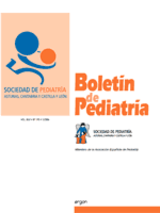Incontinencia pigmenti. Presentación neonatal
P. Alonso López , S. Castrillo Bustamante , P. Álvarez Mingorance , R. Adán Pedroso , Mª.P. Aragón García
Bol. Pediatr. 2006; 46 (195): 46 - 50
La incontinencia pigmenti es un síndrome neurocutáneo de herencia dominante ligada a X, con una variable afectación de tejidos derivados del neuroectodermo y mesodermo. Las manifestaciones clínicas más comunes son las cutáneas, pudiendo asociar otras alteraciones que aparecen en el siguiente orden de frecuencia: dentarias (en más del 80%), del sistema nervioso central (30-50%), oculares (35%) y óseas. Se presenta el caso de una neonato mujer, con lesiones cutáneas en el período neonatal inmediato que evolucionaron en los primeros meses de vida a lo largo de los tres estadios característicos: eritemovesiculoso, verrucoide y pigmentario. No existían antecedentes familiares de la enfermedad, pero el diagnóstico definitivo se realiza mediante el estudio genético de la paciente y de su madre, que muestra la deleción de los exones 4 al 10 del gen NEMO en ambos casos, así como con el estudio histopatológico de la biopsia cutánea. Existe una importante variabilidad en el grado de expresión y en la edad de presentación de la enfermedad. El diagnóstico precoz permite detectar las posibles patologías asociadas en otros órganos como las neurológicas, que son las que determinarán el pronóstico de la enfermedad. Por su posible comienzo neonatal deberá ser considerada en el diagnóstico diferencial de lesiones dérmicas vesiculoeritematosas del recién nacido. Abstract Incontinencia pigmenti is a neurocutaneous syndrome having x-linked dominant inheritance, with a variable involvement of tissues derived from the neuroectoderm and mesoderm. The most common clinical manifestations are cutaneous. Other alterations may be associated, these appearing in the following order of frequency: dental (in more than 80%), central nervous system (30%-50%), ocular (35%) and bone. We present the case of a female neonate, with skin lesions in the immediate neonatal period that evolved in the first months of life over the characteristic stages: erythematovesicular, verrucous and pigmentary. There was no family background of the disease, but the final diagnosis was made by the genetic study of the patient and her mother, that showed the delection of exons 4 to 10 of NEMO gene in both cases and with the histopathological study of the skin biopsy. There is a significant variability of the expression grade and in presentation age of the disease. Early diagnosis makes it possible to detect possible associated diseases in other organs such as neurological, that are those that will determine the disease prognosis. Due to its possible neonatal onset, it should be considered in the differential diagnosis of vesicle erythematous skin lesions of the newborn.
\N
\N
Artículo completo (PDF) (134 kb.)
- Otros
